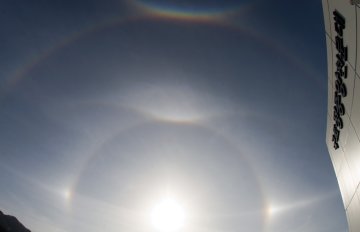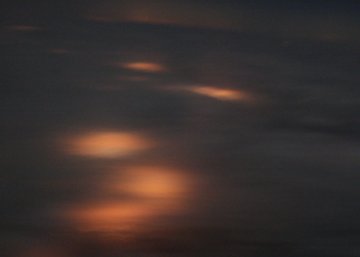 Where's Saturn? Is that a UFO--or the ISS? What's the name of that star? Get the answers from mySKY--a fun new astronomy helper from Meade. Where's Saturn? Is that a UFO--or the ISS? What's the name of that star? Get the answers from mySKY--a fun new astronomy helper from Meade. CONVERGING PLANETS: Awake at dawn? Go outside and look at Venus and Jupiter. The two brightest planets are converging in the southeastern sky for a spectacular close encounter on Feb. 1st. By the end of the month, the two planets will be so close together, you can hide them behind the tip of your index finger held at arm's length. That's worth waking up for. Sky maps: Jan. 31, Feb 1. 2, 3, 4. HALO EXTRAVAGANZA: When we see ice halos around the sun, the display is usually limited to a circular ring and one or two sundogs. On Jan. 25th, something quite different happened in the skies above Yanggu-gun, South Korea. Joon-Young Choi sends this picture from the Center of Korea Observatory: 
Photo details: Canon 300D, 33mm, ISO1600, f/4.5, 1/2 sec.
"We had it all--rings, arcs, sundogs, parhelic circles" says Choi. It was an extravaganza of atmospheric optics: diagram. What made this display special? Atmospheric optics expert Les Cowley explains: "The halos you get depend on how ice crystals in the sky are oriented. Great displays like this one have nearly all alignments. There are horizontal plate crystals making sundogs, a parhelic circle, and the colorful circumzenithal arc at top. Column crystals floating horizontally gave the upper tangent and huge supralateral arcs. Unoriented crystals gave the familiar 22 degree halo. Rare and improbably oriented Parry crystals made explorer Parry’s arc just above the 22 degree halo." Multiply-aligned crystals: another good reason to keep looking up. LIGHT POLLUTION FROM 24,000 FT: On Jan. 15th, Rick Stankiewicz looked out the window from his seat aboard a night flight from Toronto to Thunder Bay, Ontario. "I expected to see a blank slate of clouds," he says. "Instead I noticed orange glowing patches." 
"It was all too obvious what I was observing," continues Stankiewicz. "These glowing cloud patches were indicators of light pollution from communities across southwestern Ontario. This misdirected and wasted light was filtering through the cloud deck to my airplane window at 24,000 ft. I was amazed at their number; within minutes, I counted dozens of glowing patches. I used my digital camera (a Canon 400D) to capture as best as I could what I saw. There is no denying it; societies beacons of light are also signposts of wasted energy and resources." | 
